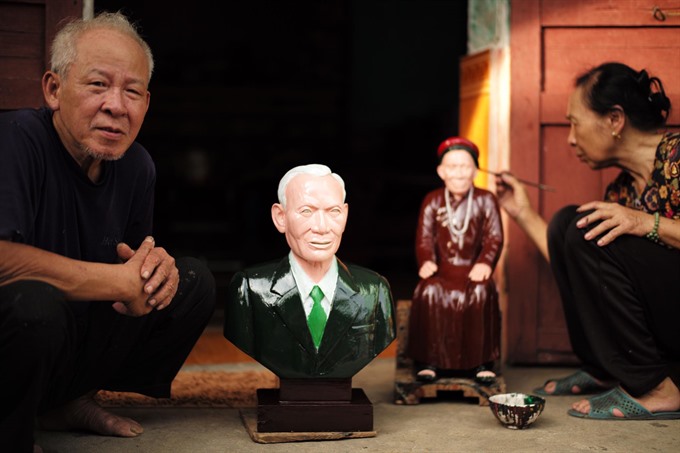 Features
Features

" />Bảo Hà Village in Đồng Minh Commune, Vĩnh Bảo District in Hải Phòng City, has been famous for the local craft of carving wooden statues for over 500 years. Local craftspeople have recently started also carving busts of people from portraits.
 |
| Careful process: Turning a piece of wood into a lively portrait may take a week or the whole month, depending on the size of the statues. |
by Thiên Hương
Bảo Hà Village in Đồng Minh Commune, Vĩnh Bảo District in
Đỗ Văn Bưởng, 68, is one of the rare residents of the village who possesses the special skills of carving busts that look exactly like the portrait on which they’re based.
The busts that he has made not only closely resemble the provided photos but also convey the soul of the people featured.
Born in to a family of wood carvers, at very a young age Bưởng was taught the family craft by his father.
His first bust was one of his grandmother he carved from a worn-out photo 30 years ago. When she passed away, his family needed a bust of her to put on the altar.
When he finished the bust, every family member was stunned that the bust looked exactly the same as the woman in the photo. Since then, residents in the region have hired him to carve busts of relatives who have passed away to put on altars. The career has brought him a steady living ever since.
Bưởng said he needed twice as much time to make his first bust as he did to make a normal statue.
After practising the craft for more than 30 years, Bưởng can hardly remember the number of busts and statues he has made.
“There are some 5,000, I think,” he said. “Besides skills of carving on wood, the art requires carvers to have a diverse imagination and good painting skills.”
Turning a piece of wood into a lively bust may take a week or the whole month to complete, depending on the size of the object.
“Sometimes I need some days to think about the way to carve on the wood,” he said. “Because the bust should not only look the same as the photo but also bear the soul of person in the photo.”
Then comes the task of selecting wood for carving.
“I prefer wood from jackfruit trees as this kind of wood lasts for long time and is easy to carve on,” he said.
This kind of wood is also preferred as it can hardly be harmed by worms.
The most challenging stage in making a bust is carving the face.
“If you just make a deeper cut than you need, the whole work may be rubbish,” he said.
When the carving is completed, he paints it and adds colour. He puts on many layers of paint on the bust before drying it on the sun, making it shiny and smooth by sand paper.
Finally, a layer of yellow paint is put on the bust.
Sometimes customers bring their own wood and ask him to use it to make the bust.
“I’m reluctant to use valuable wood that customers bring to me,” he said. “If I just make a small mistake, I may not be able to afford the same wood as compensation for them.
“But then, I have gained more confidence,” he said. “If I just carve little by little, the bust will form exactly as I want.”
 |
| Powerful paint: Bưởng said the mood on the face depends much on the painting and drawing stage. |
He often starts with smaller details like the body and clothes. Then comes the face.
“I choose carefully each small or large chisel,” he said. “Each of my carvings on the surface may create different wrinkles on the face.”
Bưởng said the mood of the face depends much in the painting and drawing stage.
“If you put too much paint in the face, you may cover careful carvings you made before,” he said. “Or if you put too little paint on the face, the bust may look moodless.”
The career has brought some troubles as well.
“Sometimes customers do not accept our work and even don’t pay any money at all,” he said.
Then all the time and energy poured into the bust are worthless, which is the reason why very few local craftmen have followed the art.
Other handmade products from the village like statues and other worship objects have been sold throughout the nation.
All of these products can be made quickly and contain none of the risks of bust-carving.
Among nearly 1,000 households in Bảo Hà, around 200 make wood statues.
According to various historical sources, in the 15th century, when the Chinese Ming troops dominated Việt Nam (1407-1427), they forced young men from Việt Nam to work in China at workshops, building mausoleums and citadels.
Nguyễn Công Huệ from Bảo Hà Village was one of them.
During his 10 years working in China, Nguyễn Công Huệ learned some trades including making busts and lacquer objects.
When he returned to the village, he taught the trade to villagers.
When he passed away, villagers built a temple dedicated to him and honoured him as the ancestor of the village’s carving craft. VNS




